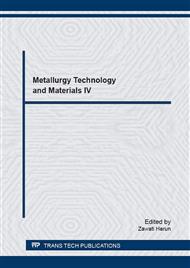p.45
p.50
p.55
p.60
p.66
p.71
p.77
p.83
p.88
Influence of Air Flow Rate and Immersion Depth of Designed Flotation Cell on Barite Beneficiation
Abstract:
This study aims to investigate the effect of flotation operating parameters such as immersion depth of downcomer and air flow rate on performance of barite minerals separation. The barite minerals utilized in this experiment mainly consist of barite and gangue minerals such as quartz, kaolinite, illite and microcline having the chemical compositions of 63.12% BaSO4, 18.22% SiO2, 13.49%Al2O3, 1.02% K2O, 0.69% Fe2O3 and 3.46% others and the particle size (d80) of about 37 microns. In the flotation cell, the air bubbles were generated using designed porous materials. The flotation of barite minerals were carried out in an alkaline condition at pH 9 with sodium oleate collector and terpineol frother. It was found that concentrate grades of barite for the air flow rates of 20, 30 and 40 L/min were nearly constant about 70% BaSO4 at the immersion depths of 5 and 10 cm but it increased at the depth of 15 cm. The immersion depth of 5 and 10 cm seems to have no effect on grade of concentrate while the depth of 15 to have such effect. The air flow rate had an effect on concentrate grade when 15 cm immersion depth was used. The optimum air flow rate of 30 L/min gave concentrate grade of 85% BaSO4 with the recovery and enrichment ratio of 73% and 1.3, respectively.
Info:
Periodical:
Pages:
66-70
Citation:
Online since:
August 2016
Authors:
Price:
Сopyright:
© 2016 Trans Tech Publications Ltd. All Rights Reserved
Share:
Citation:


